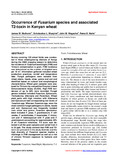Occurence of Fusarium species and associated T2-Toxin in Kenyan Wheat

View/
Date
2011Author
Muthomi, JW
Musyimi, S L
Wagacha, J M
Narla, R D
Type
ArticleLanguage
enMetadata
Show full item recordAbstract
Survey covering 120 wheat fields was conduc- ted in three wheat-growing districts of Kenya during the 2008 cropping season to determine the incidence of Fusarium head blight (FHB) and T2-toxin contamination in grain. FHB incidence was determined as the number of blighted ears per 10 m2. Information gathered included wheat production practices, rainfall and temperature data. Fungal pathogens were isolated from wheat stems, heads, straw, grains and soil and identified based on cultural and morphological characteristics. Wheat grain samples were ana- lyzed for T2-toxin by competitive Enzyme Linked Immunosorbent Assay (ELISA). High FHB inci- dences of up to 88% were recorded. Fungal genera isolated included Fusarium, Epicoccum, Trichoderma, Alternaria and Penicilium. Wheat plant parts with high infection with Alternaria and Epicoccum had corresponding low levels of Fusarium spp. Whereas Fusarium spp. were the most common fungal pathogens in stems, heads and soil, Epicoccum was frequently isolated from straw and grains. Fusarium speciesiso- lated included F. poae, F. graminearum, F. stil- boides, F. verticilloides, F. fusarioides, F. tricinc- tum and F. heterosporum with F. poae and F. graminearum accounting for approximately 40% of all Fusarium infections. T-2 toxin was de- tected in all the grain samples and varied from 3 to 22 ppb. The study showed that FHB and T2- toxin are prevalent in the study districts and the high diversity of Fusarium species implies a challenge in FHB management as well as a risk of chronic T2-toxin exposure to humans and livestock
Publisher
University of Nairobi
Description
Journal Article
